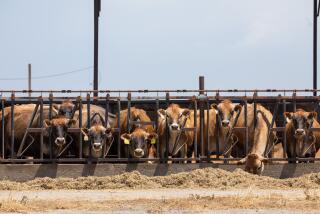‘Mad-Cow’ Disease Probe Reaches U.S.
HELENA, Mont. — Five bulls from a Canadian herd that included a cow with “mad-cow” disease were shipped to Montana six years ago and have since been slaughtered, state officials said Wednesday.
None of the animals showed clinical signs of the disease, said Karen Cooper, spokeswoman for the Montana Department of Livestock.
What became of the carcasses after the bulls were killed was unclear.
This is the first indication that the Canadian investigation into the disease known as BSE, or bovine spongiform encephalopathy, has reached into the United States.
Ron DeHaven, a spokesman for the U.S. Agriculture Department’s Animal and Plant Health Inspection Service, said the USDA believes it unlikely any of the bulls were infected with the disease, noting negative tests so far on other animals linked to the infected cow.
The slaughter would have occurred after the Food and Drug Administration had banned the use of animal parts in livestock feed.
Given that fact, DeHaven said, it is unlikely the meat would have been fed to other cattle.
DeHaven added that the chance of someone getting the human form of the disease from the five bulls is “immeasurably small.”
Two weeks ago, Canadian officials disclosed that a cow in Alberta had been identified as having the disease. The United States immediately banned all imports of Canadian beef and cattle.
Canada has since ordered the slaughter of more than 1,700 cattle in its effort to determine the disease’s source.
So far, 800 animals have tested negative, including animals that had been in the same herd as the infected cow.
Canadian authorities said on Wednesday that some of the bulls from Alberta apparently were subsequently resold in South Dakota and Montana.
“Mad-cow” disease was first diagnosed in Britain in 1986.
More to Read
Sign up for Essential California
The most important California stories and recommendations in your inbox every morning.
You may occasionally receive promotional content from the Los Angeles Times.










